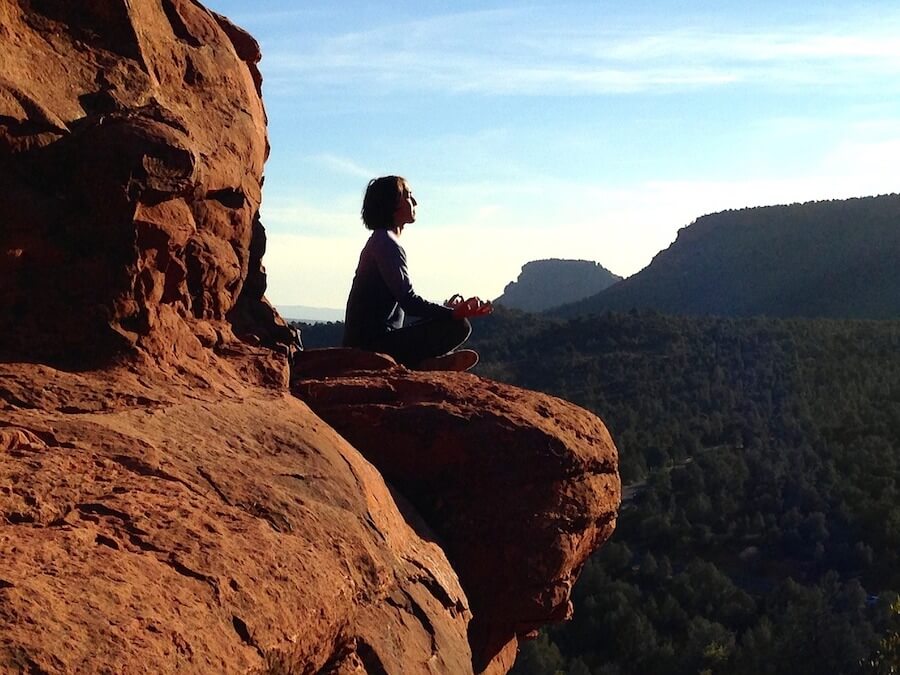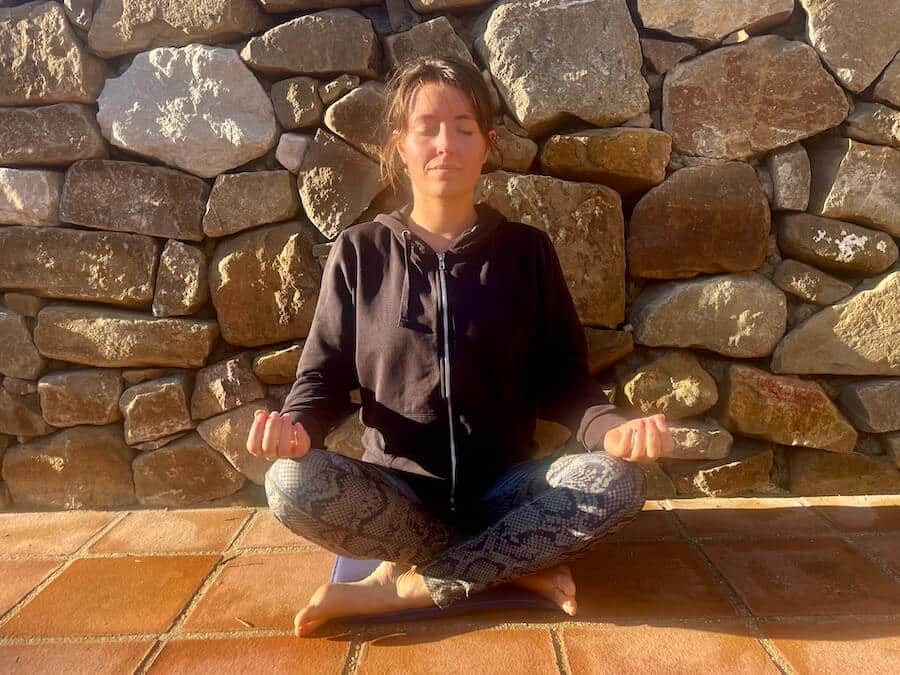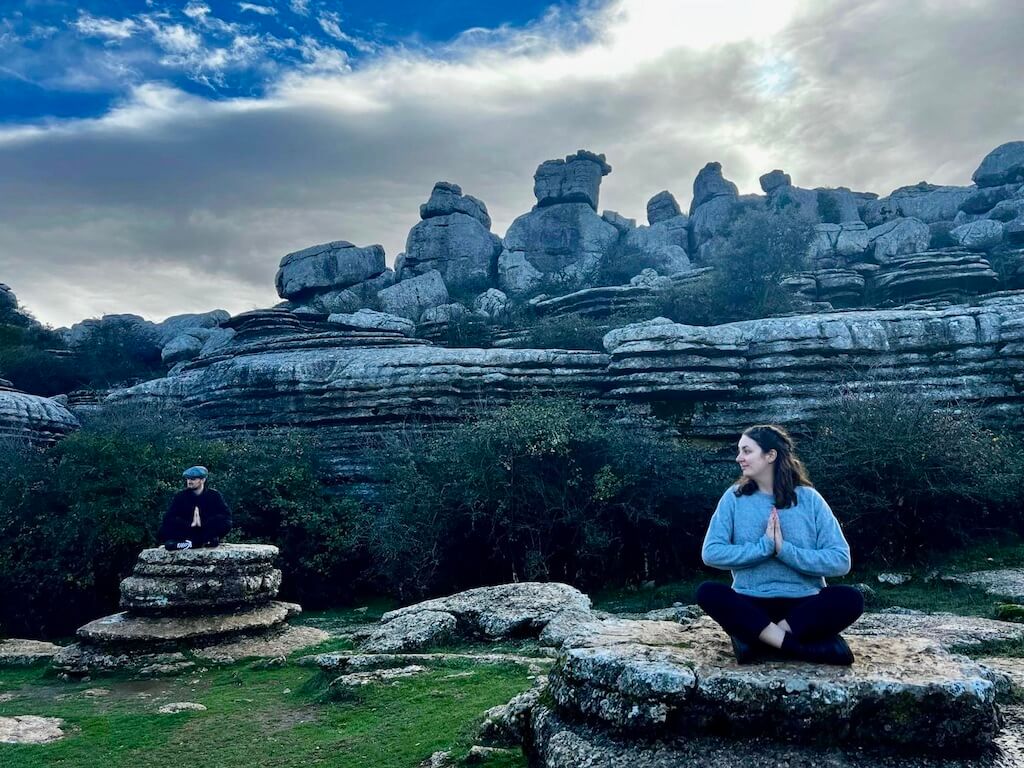Do you think while meditating? You sit down and suddenly, Wham!
Your brain’s shuffled itself into low gear and become super-charged with a zillion thoughts, all running through your head at the same time.
That crazy old brain interrupting your meditation!
Or maybe you manage to still your mind for a moment, only to find a minute later that your day’s being replayed in your inner cinema.
Or you’re creating a loop, the same thoughts over and over, thoughts of how offended you are after being insulted by someone.
If so, chill. It’s normal.
Yeah, we’ve all been there, wondering about that chattering mind.
But don’t worry, it’s perfectly normal and in this article we’re going to explore how to meditate and quieten that little chatterbox.
Even if you think you can’t meditate, you can.
But don’t expect the mind to just roll over and be silent, because it’s the mind’s job to produce thoughts.
For more on how to still the thoughts, read on.
(Featured image by chuck herrera on Pixabay)
Table of Contents
Only Have 5 Minutes? Summary of Do You Think While Meditating
Thoughts still pass through your mind while you’re meditating but you don’t interact with those thoughts, so you don’t actively ‘think’, even though thoughts are still being produced (especially in the early days). You could say that you’re thinking with one track of your mind – until it too becomes quiet and you reach the elusive place of oneness. The difference with these thoughts is that when you’re meditating you’re the observer of the thoughts, eventually transcending the thoughts altogether for brief moments (or more). During the process, you become aware of the ‘you’ who is observing, so you’re not actively engaged in thinking, even though there are still thoughts being produced by your mind. Of course during meditation you may find yourself interacting with these thoughts and actively ‘thinking’, but as soon as you notice that, you return your focus away from the thinking process and back to your breathing. In this way you can learn much about yourself and that’s one of the beauties of meditation, the art of self-knowledge.
Do Thoughts Stop While Meditating?
First off, thoughts don’t just stop when you take up meditating.
It’s a miscommunication or a misinterpretation of what meditation actually is, to think that thoughts stop rolling when you sit down to meditate.
Ok, but if thoughts don’t stop, then what, you’re sitting there thinking?
No. Because thinking is a two-way activity. During the activity of thinking, a thought occurs and the thinker reacts to it, thus creating a dialogue around the thought.
When you meditate, the thoughts still appear but you stop interacting with them. You learn to see what’s really going through your mind.
In other words, you become aware of the traffic!
You become aware of you, from your inner observer’s point of view. A non-judgemental observation with nothing more attached to it. In this way you can learn mindfulness skills on your own, through meditation.
In the beginning it can be difficult to not interact with the thoughts. Yeah, I know because we all go through it.
It can happen that suddenly, before you know it, you’re in full blown thought-conversation with a stream of thoughts. And that’s when you were trying to be still.
It can be especially hard in the beginning but it’s like a muscle which needs training. With time and practise it becomes easier.
Honest.
The more practise you get with observing your thoughts, the easier it becomes.
You find ways to slow down the chatter. And that’s one of the beautiful experiences of meditation.
The more you practise meditation, the more fluidly and easily you slip into become the observer, until eventually the thoughts slow down so much they appear to almost cease.
And that’s when you get the incredible, indescribable feeling which comes from regular meditation.
The job of the thinking mind is to produce thoughts.
So that’s what it does.
It doesn’t miraculously stop doing its job the first time you sit to meditate.
But with practise, as you become more used to meditating, your thoughts will slow down and you will be able to feel the oneness and joy.
To become completely absorbed and non-thinking is the work of meditation.
Thoughts & Early Days of Meditation
At first, it can seem that your thoughts speed up and bombard you as soon as you try to be still.
This is logical.
Firstly, if you aren’t used to being aware of your thoughts, sitting in silence can turbo-charge your thought process. Which can surprise you because we think a hell of lot of thoughts in a day!
They say we have between 60,000 and 80,000 thoughts a day.
So imagine if you’ve never watched them and suddenly you see the little critters running around like crazy through your mind.
It’s going to seem pretty hectic the first time you see it.
Secondly, because you’re trying not to think, but your mind’s programmed to think, so of course it will resist. It may even send out extra thoughts to get your attention.
So it’s quite normal, and don’t worry about it if you think your mind’s going at crazy-speed thinking when you first start meditating.
It will come good, I promise.
Thoughts & Regular Practise of Meditation
As you meditate more often, you’ll find it easier to quieten your thoughts.
It’s like a muscle, and it can be made stronger by using it.
It’s not that your thoughts will stop completely, but they will slow down.
There are various ways to entertain the busy part of your mind so that it doesn’t churn out thoughts all the time, but the simplification of it all is that in the beginning you cultivate the ability watch your own mind at work.
And then you become aware that you are not your thoughts.
Your thoughts are not facts.
Neither are they things.
They’re just thoughts, passing through the screen of your mind.
As you go deeper into the meditation you transcend even the observer. It may be just for momentary glimpses at first or for longer periods where you are unattached and connected to the Oneness.
You may feel a profound joy.
Love.
Awe.
It’s a boundless, limitless kind of love and joy blended together which is difficult to describe but can only be felt.
You may also receive intuitive messages to help you in your life journey, or a solution to a problem may spring alive within your mind just after meditation for example.
And if you practise a self-guided meditation, you can experience interactions with mythical beings or spirit guides.
These images spring up to life from within without actually engaging the thinking part of the brain.
They spontaneously appear before your mind’s eye, ready to share with you what it is you need to hear.
Setting Up Meditation Space
There are different ways to occupy the mind while meditating. You may need to experiment a bit until you find the method which works best for you or resonates the most.
But before you start, choose the space where you’re going to meditate.
Don’t worry, you don’t have to have a dedicated room for this, just a corner where you feel comfortable and where you won’t be disturbed or distracted.
Of course you can also meditate when you’re out and about, standing in a queue, or even meditate while you’re travelling.
You may choose to meditate with music or without and each experience gives a very different meditation.
Personally, I like to meditate without music for my regular practice and with music for extra bonus on occasion.
I find the silent meditation takes me deeper into myself. But music can still be a good option, especially if you’re struggling to quieten the mind, (but don’t struggle, just accept!).
The next question you might wonder is whether you should meditate in the dark, and again, it depends on your own circumstances.
Meditating in the dark is another great tool in your kit to help quieten the mind. And it can boost your meditation for sure.
Then, you ask whether you can meditate with your eyes open or should you keep them closed? Both are possible but keeping your eyes closed can help to quieten the mind more easily as there are no visual distractions.
If you’re doing your meditation in complete darkness, then having the eyes slightly open and gazing gently downwards is also fine.
Now that’s settled, it’s time to begin. . .
What to do With Your Mind When Meditating
There are lots of ways to quieten the mind and here are a few that I’ve used to distract the monkey mind and settle in to the meditation.
Focus on the Breath
A very popular way to meditate is to bring your awareness to the breath as it comes in and out. Feel the air on the nostrils entering into your nose, then down through to your lungs and back up on exhalation, exiting the nostrils once more.
Your only job is to remain with the breath. In, out . . . in, out. . .
And come back to the breath when you get distracted.
You can choose to focus on the rise and the fall of the chest, on the air as it passes your nostrils, or on your exhale, following the exhale down to the the end.
This zen meditation video shares how to meditate with awareness to the exhale of the breath.
I normally tune in to the rise and fall of my chest, or to following the exhale down to the end.
With each breath count upwards from 1-10 (with each breath in and out being one count). When you reach 10, you start again.
You can also start again every time you find yourself thinking a thought. So in the beginning you might only make it to 3 for example and then, after regular meditating, find that you can get to 5 before a thought kicks in, and so on.
Instead of counting, you can silently say ‘in’ and ‘out‘ with the breath.
Or you could use a mantra.
Repeating a word like this helps to keep the busy mind busy and on track, distracted from its job of creating thoughts and therefore slowing it down.
Bring Attention to Your Third Eye
Also linked to the breathing, you can send your breath in your mind’s eye to your third eye (the area directly between and slightly above your eyebrows).
This is slightly more complicated than just focussing on your breath so I would recommend starting out with the breathing and saving this for experimenting with once you’re comfortable with your thoughts quietening down.
You can also visualise a white healing light flowing from above and into the third eye.
Go on an Inner Journey during Meditation
I love going on an inner journey during meditation.
In this case, you have one voice which guides you, and this single voice keeps the thought-producing mind quiet.
The way I practise journeying is influenced by self-hypnosis and by going on a journey, as practised in a Shaman meditation technique.
I love this kind of meditation, though it’s a very different experience to a silent meditation. To do this, begin to relax your body (this is where I sometimes use self-hypnosis techniques) before you start the meditation.
Next, imagine you’re walking along a path. Feel the earth beneath your bare feet. Allow your imagination to produce your surroundings.
Look around you.
What do you see?
What can you hear?
The whole journey takes you to your beautiful garden and through a lake and into your own spiritual caves where you can meet with your inner child or your power animal or spirit guide. You may meet with long lost loved ones or a combination of all.
The beauty of this meditation is that you aren’t ‘thinking’ this scenario. You first get into deep relaxation and then you simply start off the journey.
Once it’s begun, you allow it to unfold.
If you find yourself caught up in creating the images, then you haven’t entered into the deep meditation.
But don’t worry, keep practising.
It’s a wonderful journey to be able to go on, especially for asking questions during your meditation or connecting to your inner wisdom.
If you’re interested in going on a spiritual journey during meditation, this is just a brief introduction. To succeed I recommend reading about it in more depth.
Why Meditate Daily?
Meditating daily brings so many benefits and as you practise it you become more familiar with your practise, and your mind strengthens, just like a muscle at the gym.
You receive many gifts in return for regular meditation practise.
To name just a few, meditating can . . .
- Make you less reactive to difficult situations.
- Keep you calm when you would before have panicked.
- Give complete relaxation.
- Counter the effect of stress in your life.
- Bring more awareness to specific situations.
- Offer intuition and insights into your life.
- Help you make important decisions.
- Lower high blood pressure.
- Boost the imagination and creativity.
- Give you inner strength and conviction.
- Build resilience and trust in the process.
As well as all these benefits, with the help of meditation, you can learn to change specific behaviour like changing your relationship to alcohol, learning how not to give up too easily, and how to not get offended by insults.
Final Thoughts: Do You Think While Meditating?
The joy of meditation, the absolute pure inner joy can be felt in that space between thought, that moment when the chattering has stopped.
You may reach this place for a long while or for just a moment, but when you feel it you know it. It speaks to you of the wonders of life in a way that no words can.
And the power of meditation gets stronger with practise. If you don’t feel it when you first meditate, you’re not strange. You’re not the one unique person who can’t meditate.
It just means you need to practise more until you find the way which resonates most with you.
And then some more to strengthen your super powers.








